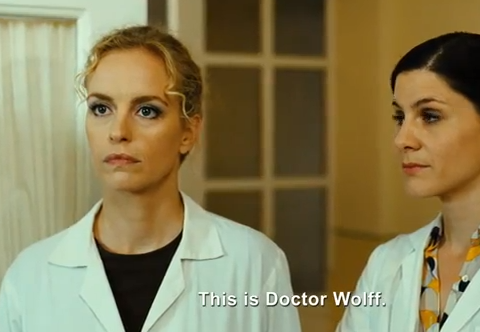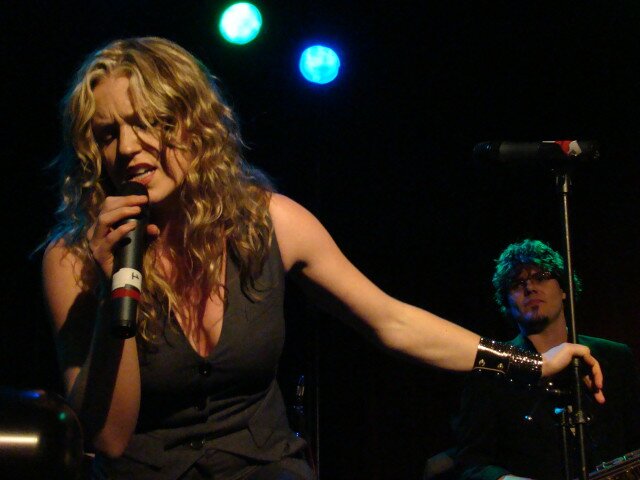Lately I’ve been wondering: What is the best bite from the ocean? What seafood do I find most seductive?
There are plenty of great choices. I love sea urchin and oysters, and when Ethan Stowell puts them together, you get the best combination of seafood I’ve ever eaten. I’m crazy about clams (especially razor clams), and find the texture of these and other bivalves tantalizing. At sushi restaurants, I’ve admittedly enjoyed bluefin tuna, and even eaten at maguro restaurants in Japan, but with awareness of overfishing, I’ve really tried to limit my consumption to near zero. And since visiting the Creative Salmon farm near Tofino, I’ve been giving a lot of thought to the debate between farmed and wild salmon, with Creative teaching me that sometimes there are no easy answers to the challenge of sustainable seafood and finding our way with food in the future.
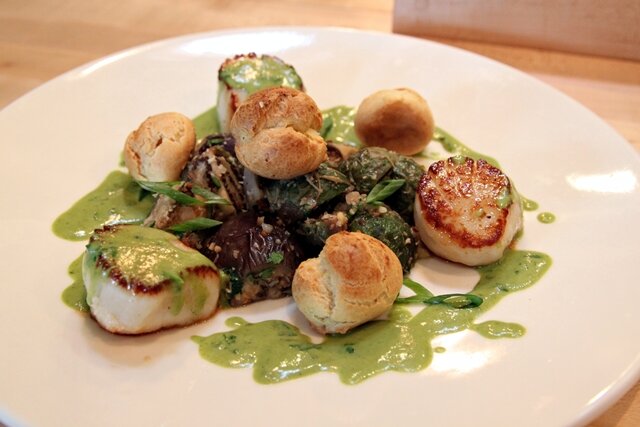
I’ve reached a realization that, for me, the pinnacle of perfection in seafood may be the scallop.
A jewel of the sea, this bivalve mollusk comes in a beautiful shell and is bursting with flavor. The scallop is at once savory and sweet. They’re easy to cook; like steak, you want to sear them on the outside in a very hot pan, but leave them basically rare on the inside to preserve their soft texture and sweetness. You can also eat scallops raw as sashimi, or squirt them with citrus to make ceviche.
In addition to being delicious, scallops are good for you. They’re full of omega-3 fatty acids, B12, magnesium and potassium. All contribute to cardiovascular health, another reason to heart scallops.
As an added bonus, scallops get good marks from Monterey Bay Aquarium Seafood Watch. The key is to buy “dry” scallops instead of “wet” ones. Dry scallops, like Weathervanes, are caught wild and immediately frozen at sea to keep at a high quality level. They’re said to have an almost vanilla color.
Wet scallops, on the other hand, are treated with preservatives and chemicals, typically phosphates (like sodium tripolyphosphate), which artificially “pump up” the scallops to make them look bigger. More snowy white in color, you pay for the increased water content, only to find them shrink during cooking and become dry and tasteless. (It’s also difficult to caramelize wet scallops.)
Lastly, on the sustainability front, farmed scallops like those from Qualicum Bay in British Columbia look promising. The Qualicums are actually a cross between a Japanese scallop (Patinopecten yessoensis) and the Weathervane (Patinopecten caurinu). Generally available year-round, I’m told that it’s been tough to get these scallops in recent months, but once you find them, they’re about the sweetest you’ll ever have.
If you’re as enamored with scallops as much as I am, here’s what I see some local restaurants doing with these sweet treasures from the sea.
 Tanglewood Supreme
Tanglewood Supreme
Tanglewood Supreme in Magnolia may be the best new hidden gem in our local restaurant scene. Striving for sustainability, this “local seafood bistro” serves ocean treats that are fished with good practices. And while there’s a Northwest focus to the menu, there are plenty of Asian and Mediterranean influences to make the food interesting.
Currently on the dinner menu, you’ll find Alaskan Weathervane scallops with macadamia nuts, Thai and Indian eggplant, green curry, and naan puffs. My scallops were perfectly seared, with the plate drizzled with just enough curry that I could dabble with how much I wanted those scallops sauced. Not timid with the heat (but not overwhelmingly spicy), the curry is a complement to the slightly bitter eggplant, and the puffs add a playful element to the presentation.
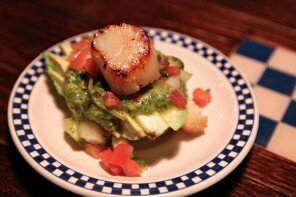 Duke’s Chowder House
Duke’s Chowder House
Duke Moscrip, owner of the local Duke’s Chowder House chain, is an enthusiastic advocate of high quality, sustainable seafood. Earlier this year, I accompanied him on a trip to Westport to see how Pacific Seafood peels, cooks, and packages shrimp at their processing plant. His latest passion appears to be scallops, featuring Weathervane scallops on a special menu. He calls them OMG (Oh My God) scallops, touting their tenderness and sweetness and saying that they scream for simplicity.
The menu includes a surf-and-turf option of ribs with scallops and shrimp (my scallops were way overcooked, though I’m told the issue is being addressed) and bacon scallop tacos (the scallop pieces were not quite as overcooked, but the flavor somewhat lost in the midst of Thai chili sauce, tequila lime aioli, and cucumber pico de gallo—combined with the blueberry tortilla, this smacked more of Momiji sushi roll syndrome than the simplicity I was seeking). Best bet might be the topless scallop slider, served on bite-sized sourdough bread with pesto, avocado, and cucumber pico de gallo.
 Coastal Kitchen
Coastal Kitchen
Scallops are one of chef Jason Jones’ favorite ingredients at Coastal Kitchen—a restaurant which has been serving sustainable seafood since 1993. Rather than lamenting the difficulty of sustainability, he feels that we should embrace the challenge. Specific to scallops, he says “they’re a delicacy, and while they may seem prohibitively expensive, we should slow consumption and simply appreciate them.”
The day I went it, the special was pan-seared scallops with sunchoke risotto, porcini mushrooms, and watercress. As at Tanglewood Supreme, the scallops were perfect—nicely caramelized on the outside, soft and tender on the inside. The risotto and mushrooms were rich and earthy, while the watercress offered a refreshing counterbalance to the dish.
 Fish Hooks Fish Grill
Fish Hooks Fish Grill
This new, family-friendly restaurant at the top of Queen Anne features enthusiastic staff, perhaps to the point of service being too friendly and not formal enough. Chef-owner Paul Saito says that he strives for sustainability (“I want to avoid things like Chilean sea bass”), but can’t always keep that goal with dishes at the lower price point that Fish Hooks Fish Grill offers.
As an example, he uses Weathervane or “similar” scallops in his premium plates, and dry, large bay scallops for his fried dishes. I tried the Crispy Combo of prawns and scallops, and found the seafood to be overcooked, with the breading completely overwhelming the flavor of both the prawns and scallops. (I preferred the fish and chips, as the large pieces of cod provided a better breading-to-fish ratio, though I’m not a fan of the “rustic” batter—or the fries, for that matter.)
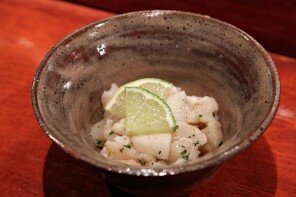 Mashiko
Mashiko
At this sustainable sushi restaurant in West Seattle, chef-owner Hajime Sato serves seafood that is as local, seasonal, and fished with caring environmental practice as possible. He’s a fan of Weathervanes and also supports farmed scallops, as they’re filter feeders and easy to grow. (Wild scallops are often dredged, which can destroy the sea floor.) Like me, he wonders why so many Americans throw away other good parts the scallop, like the abductor muscle and the roe. Texture is apparently not something we have a taste for…yet.
Sit at the counter at Mashiko and order omakase, letting Sato serve you what he wishes, and you’ll get good education (non-preachy) and delicious dishes (you can tell him some of your preferences). During a recent visit, I enjoyed a geoduck, scallop, and Japanese pear ceviche that I thoroughly enjoyed. The contrast in texture between the geoduck and scallop was fun, and the slight sweetness of the pear enhanced the eating experience.
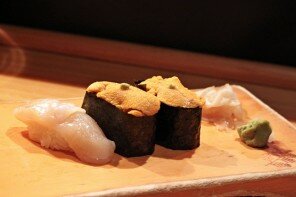 Kisaku
Kisaku
After all the combinations and preparations and “cooking” techniques and sauces and flavorings, my favorite way to eat scallops might be the most simple: as sashimi or sushi. The soft texture is comforting and the natural, oceanic sweetness still thrills me. You can enjoy scallops as part of your sushi meal at Kisaku in Tangletown, but I’d like to let you in on something better.
Upon arrival, ask chef-owner Ryuichi Nakano to prepare hotate konbu jime. (Tell him I sent you, though he may already figure that out!) Nakano wraps the scallop (he uses dry ones from Hokkaido) in kelp and lets it sit for at least 30-45 minutes, amping the scallop up with umami. There’s no need for wasabi or soy sauce in this preparation. It’s absolutely delicious, and at the end of the day, my favorite way to eat scallops.



